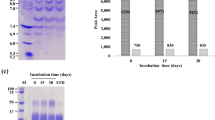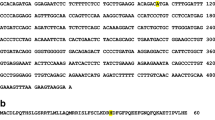Abstract
Purpose. Two recombinant IFN-β products have been approved for the treatment of multiple sclerosis, a glycosylated form with the predicted natural amino acid sequence (IFN-β-la) and a non-glycosylated form that has a Met-1 deletion and a Cys-17 to Ser mutation (IFN-β-lb). The structural basis for activity differences between IFN-β-la and IFN-β-lb, is determined.
Methods. In vitro antiviral, antiproliferative and immunomodulatory assays were used to directly compare the two IFN-β products. Size exclusion chromatography (SEC), SDS-PAGE, thermal denaturation, and X-ray crystallography were used to examine structural differences.
Results. IFN-β- la was 10 times more active than IFN-β- Ib with specific activities in a standard antiviral assay of 20 × 107 lU/mg for IFN-β-la and 2 × 107 lU/mg for IFN-β-lb. Of the known structural differences between IFN-β-la and IFN-β-lb, only glycosylation affected in vitro activity. Deglycosylation of IFN-β-la produced a decrease in total activity that was primarily caused by the formation of an insoluble disulfide-linked IFN precipitate. Deglycosylation also resulted in an increased sensitivity to thermal denaturation. SEC data for IFN-β-lb revealed large, soluble aggregates that had reduced antiviral activity (approximated at 0.7 × 107 lU/mg). Crystallographic data for IFN-β-la revealed that the glycan formed H-bonds with the peptide backbone and shielded an uncharged surface from solvent exposure.
Conclusions. Together these results suggest that the greater biological activity of IFN-β-la is due to a stabilizing effect of the carbohydrate on structure.
Similar content being viewed by others
REFERENCES
W. E. Stewart. The interferon system. Springer Verlag, New York (1981).
G. Sen and P. Lengyel. The interferon system: a bird's eye view of its biochemistry. J. Biol. Chem. 267:5017–5020 (1992).
G. Uze, G. Lutfalla, and K. E. Mogensen. Alpha and beta interferons and their friends and relations. J. Interferon Cytokine Res. 5:3–26 (1995).
M. Peters. Actions of cytokines on the immune response and viral interactons: an overview. Hepatology 23:909–916 (1996).
S.K. Tyring. Interferons: Biochemistry and mechanisms of action. Am. J. Obstet. Gynecol. 172:1350–1353 (1995).
B. Weinstock-Guttman, R. M. Ransohoff, R. P. Kinkel, and R. A. Rudick. The interferons: biological effects, mechanisms of action, and use in multiple sclerosis. Ann. Neurol. 37:7–13 (1995).
S. Baron, D. H. Coppenhaver, F. Dianzani, R. Fleischmann, T. K. Hughes Jr., G. R. Klimpel, D. W. Niesel, G. J. Stanton, and S. K. Tyring. Interferon: principles and medical applications. The University of Texas Medical Branch at Galveston; Dept. of Microbiology. Galveston, TX (1992).
L. D. Jacobs, D. L. Cookfair, R. A. Rudick, R. M. Herndon, J. R. Richert, A. M. Salazar, J/ S Fischer, D. E. Goodkin, C. V. Granger, J. H. Simon, J. J. Alam, D. M. Bartoszak, D. N. Bourdette, J. Braiman, C. M. Brownscheidle, M. E. Coats, S. L. Cohan, D. S. Dougherty, R. P. Kinkel, M. K. Mass, F. E. Munschauer, III, R. L. Priore, P. M. Pullicino, B. J. Scherokamn, B. Weinstock-Guttman, R. H. Whitham, and the Multiple Sclerosis Collaborative Research Group. Intramuscular interferon-beta-1a for disease progression in relapsing multiple sclerosis. Ann. Neurol. 39:285–294 (1996).
The IFNβ multiple sclerosis study group. Interferon-beta-1b is effective in relapsing-remitting multiple sclerosis. I. clinical results of a multicenter, randomized, double-blind, placebo controlled trial. Neurology 43:655–661 (1993).
Y. Kagawa, S. Takasaki, J. Utsumi, K. Hosoi, H. Shimizu, N. Kochibe, and A. Kobata. Comparative study of the asparagine-linked sugar chains of natural human interferon-β 1 and recombinant human interferon-β 1 produced by three different mammalian cells. J. Biol. Chem. 263:17508–17515 (1988).
R. Derynck, E. Remaut, E. Saman, P. Stanssens, E. De Clercq, J. Content, and W. Fiers. Expression of the human fibroblast interferon gene in Excherichia coli. Nature 287:193–197 (1980).
D. F. Mark, S. D. Lu, A. A. Creasey, R. Yamamoto, and L. S. Liu. Site-Specific mutagenesis of human fibroblast interferon gene. Proc. Natl. Acad. Sci. USA 81:5662–5666 (1984).
J. Alam, S. Goelz, P. Rioux, J. Scaramuccii, W. Jones, A. McAllister, M. Campion, and M. Rogge. Comparative pharmacokinetics and pharmacodynamic of two recombinant human interferon beta-1a (IFNβ-1a) Products Administered Intramuscularly in Healthy Male and Female Volunteers. Pharm. Res 4:546–549 (1997).
L. M. Jost, J. M. Kirkwood, and T. L. Whiteside. Inproved short-and long-term XTT-based colorimetric cellular cytotoxicity assay for melanoma and other tumor cells. J. Immunol. Meth. 147:153–165 (1992).
P. P. Wingfield, G. Graber, N. R. Trucatti, M. Movva, S. Pelletier, Craig, K. Rose, and C. G. Miller. Purification and characterization of a methionine specific aminopeptidase from Salmonella Typhimurium. Eur. J. Biochem. 180:23–32 (1989).
H. S. Conradt, H. Egge, J. Peter-Katalinic, W. Reiser, T. Siklosi, and K. Schaper. Structure of the carbohydrate moiety of human interferon beta secreted by a recombinant Chinese hamster ovary cell line. J. Biol. Chem. 262:14600–14605 (1987).
M. Karpusas, M. Nolte, C. B. Benton, W. Meier, W. N. Lipscomb, and S. E. Goelz. The crystal structure of human interferon-β at 2.2 Å resolution. Proc. Natl. Acad. Sci. USA 94: 11813–11818 (1997).
N. J. Murgolo, W. T. Windsor, A. Hruza, P. Reichert, A. Tsarbopoulos, S. Baldwin, E. Huang, B. Pramanik, S. Ealick, and P. P. Trotta. A homology model of human interferon α-2. Proteins: Struc., Func., Gen. 17:62–74 (1993).
T. Senda, S. Saitoh, and Y. Mitsui. Refined crystal structure of recombinant murine Interferon-β at 2.15 Å resolution. J. Mol. Biol. 253:187–207 (1995).
R. Radhakrishnan, L. J. Walter, A. Hruza, P. Reichert, P. P. Trotta, T. L. Nagabhushan, and M. R. Walter. Zinc mediated dimer of human interferon-α2b revealed by x-ray crystallography. Structure 4:1453–1463 (1996).
Y. Mitsui, T Senda, T. Shimazu, S. Matsuda, and J. Utsumi. Structural, Functional and enolutionary implications of the three-demensional crystal structure of murine interferon beta. Pharmacol. Ther. 58:93–132 (1993).
T. W. Rademacher, R. B. Parekh, and R. A. Dwek. Glycobiology. Ann. Rev. Biochem. 57:785–838 (1988).
J. C. Paulson. Glycoproteins: What are the sugar chains for? Trends Biochem. Sci. 14:272–276 (1989).
H. Lis and N. Sharon. Protein glycosylation: structural and functional aspects. Eur. J. Biochem. 218:1–27 (1993).
C. Wang, M. Eufemi, C. Truano, and A. Giartosio. Influence of the carbohydrate moiety on the stability of glycoproteins. Biochemistry 35:7299–7307 (1996).
S. E. O'Connor and B. Imperiali. Modulation of protein structure and function by asparagine-linked glycosylation. Chem. and Biol. 3:803–812 (1996).
Y. Watanabe and Y. Kawade. Properties of non-glycoslated human interferon-β from MG63 cells. J. Gen. Virol. 64:1391–1395 (1983).
R. Gibson, S. Schlesinger, and S. Kornfeld. The non-glycosylated glycoprotein of vesicular stomatitis virus is temperature-sensitive and undergoes intracellular aggregation at elevated temperatures. J. Biol. Chem. 254:3600–3607 (1979).
S. Dube, J. W. Fisher, and J. S. Powell. Glycosylation at specific sites of erythropoietin is essential for biosynthesis, secretion and biological function. J. Biol. Chem. 263:17516–17521 (1988).
D. T. W. Ng, S. W. Hiebert, and R. A. Lamb. Different roles of individual N-linked oligosaccharide chains in folding, assembly, and transport of the simian virus 5 hemmagglutinin-neuraminidase. Mol. Cell. Biol. 10:1989–2001 (1990).
D. Davis, X. Liu, and D. L. Segaloff. Identification of the sites of N-linked glycoslyation on the follicle-stimulating hormone (FSH) receptor and assessment of their role in FSH receptor function. Mol. Endo. 9:159–170 (1995).
M. E. Mathieu, P. R. Grigera, A. Helenius, and R. R. Wagner. Folding, unfolding and refolding of the vesicular stomatitis virus glycoprotein. Biochemistry 35:4084–4093 (1996).
Author information
Authors and Affiliations
Rights and permissions
About this article
Cite this article
Runkel, L., Meier, W., Pepinsky, R.B. et al. Structural and Functional Differences Between Glycosylated and Non-glycosylated Forms of Human Interferon-β (IFN-β). Pharm Res 15, 641–649 (1998). https://doi.org/10.1023/A:1011974512425
Issue Date:
DOI: https://doi.org/10.1023/A:1011974512425




